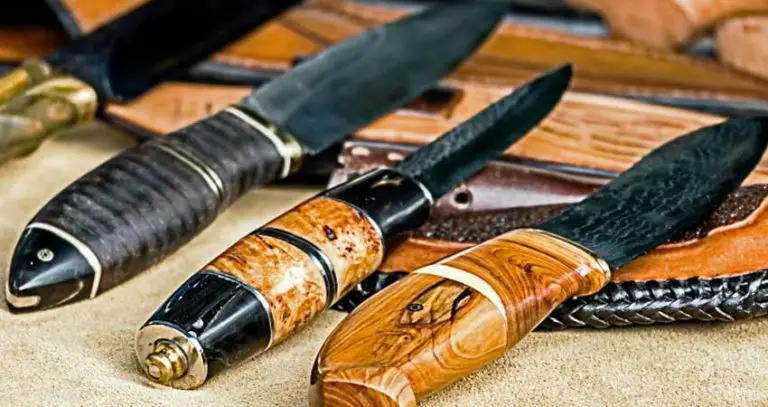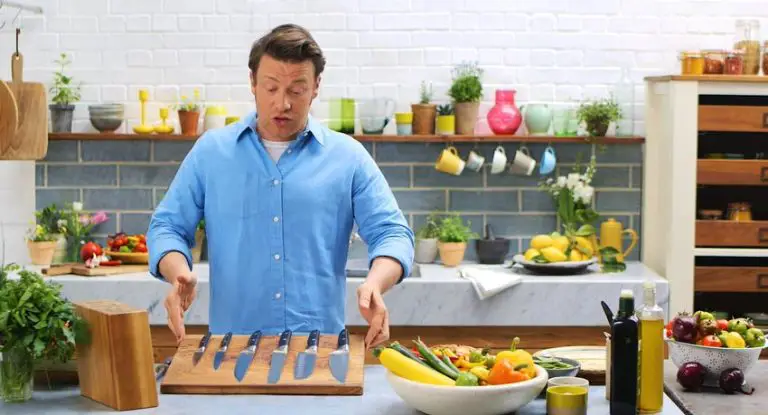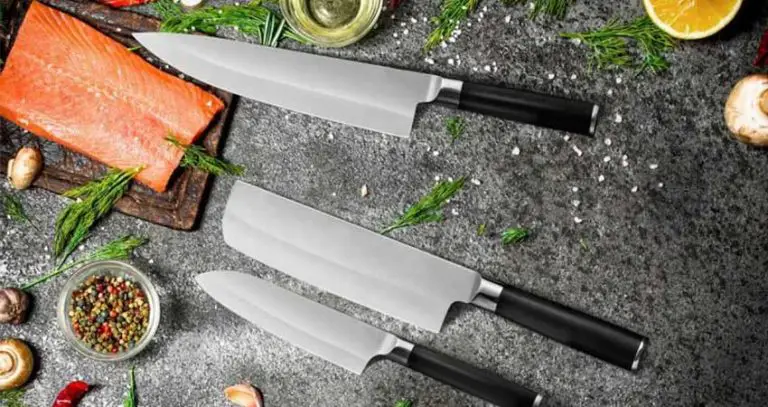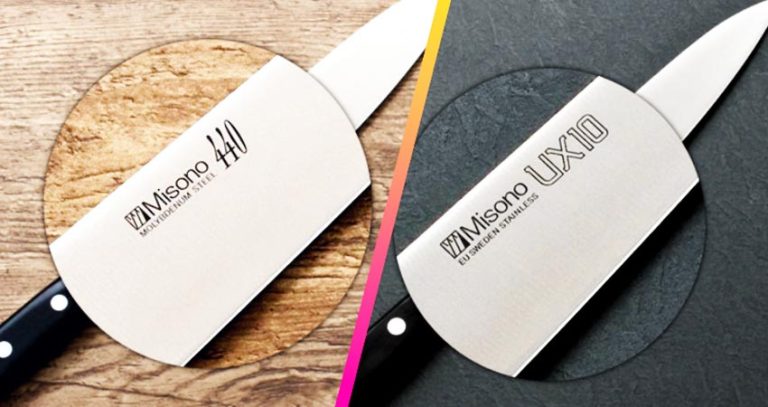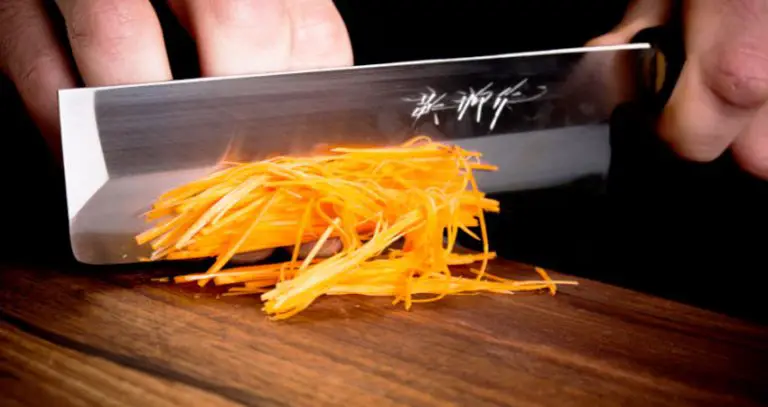How To Hold Japanese Knife-Culinary Skills
With Japanese knives, you must follow certain rules. Because they are much sharper and not cutting the proper way might be a risk that you don’t want to take.
The knife is so sharp that one time I cut my finger once and before I can fully realize I gave myself a second cut.
Moreover, what is the benefit of buying a specially designed knife if you don’t take advantage of it.
So, you must know how to hold Japanese knife like a pro!
In this article, we are going to cover all the basic skills you should know about chopping with Japanese knives – different grips, precautions, cutting motions, etc.
Keep in touch with us to see how the villain (knife) attack the victims (the food).
Safety / Preparation For Holding Japanese Knife

Before starting, you need to collect the following items-
- Cutting Board: If you washed it and it is somewhat wet, let it dry. It’s better to put a towel or non-slip mat under the cutting board to prevent the board from sliding around.
- Knife, the Villain: Now, you need a sharp knife. Probably you heard the strange rule- “Sharp knife is safer than a dull one.” Because dull knives need more force to cut, and if accidentally, it slips. Ouch!
- Victim (something to cut): If you are a novice, we can suggest to you some veggies choose. Cucumbers, zucchini, and celery are some of them.
Well, the field is ready. Let’s set our movie! But take these precautions so that villains can attack the victim but not the producer of the movie (your hand).
- Cutting board placement: The cutting board should be placed only 2-3 cm from the counter’s edge. The distance should be enough not to let the board fall off from the counter. Plus, it’s not too far away that you’ll have to lean or extend too much.
- Put the knife safely after every use: The knife is so sharp that it can cost you a deadly hemorrhage. So, when you’re not using it, put it somewhere far away from you on the board. Plus, face the cutting edge oppositely.
- Always mince away from your hand to reduce the possibility of damage if the blade slides.
Stance / Body Position For Holding Japanese Knife
Believe it or not, the correct posture may dramatically change your cutting efficiency! Plus, if you have to cut, slice, chop for a long time, the wrong posture may result in chronic shoulder and wrist pain.
The following stance allows you to make the most of your energy while maintaining your focus on the foods.
- First of all, never try to cut sitting in a chair.
- Stand a few centimeters away from the countertop.
- Keep your body parallel to the cutting board.
- Spread feet shoulder-width apart.
- Then, you have to make an angle between the waist (not your forehand) and the board. It should be about 45°. You can achieve this diagonal position by one of the following steps:
- Step back your right foot (if you’re right-handed) until the waist, and the board reaches a 45° angle
- Or, keep your left foot straight. Step the right foot a little bit back and then rotate clockwise till it reaches a 45° angle
It might seem strange at first to keep this position during the cutting time. However, you should try to maintain this posture as much as possible.
Hold the posture for at least 90% of the cutting time.
You can follow your breathing like you would when doing meditation. This will allow you to concentrate. Plus, you won’t feel tired even after cutting tons of vegetables.
How To Hold Your Japanese Knife
Up here, our plot is ready. Now, we’ve to get our control over the villain, the Japanese knife. In the end of this section, you’ll discover three distinct grip styles that professional chefs use.
Pinch Grip

Would you feel weird if I suggested you have the control and balance on your Japanese knife by touching the spine of the blade? Pinch grip works that way.
Pinch the blade between the index and your thumb. Let me clarify the method!
- Handling the pinch grip, grasp the blade with your thumb on one side and index on the opposite side. Hold it in pinching motion.
- Make sure the first knuckle of your index is in touch with the blade. Now, let other fingers rest around the handle of the knife.
- Japanese knives are manufactured uniquely. Here handles are mainly to counterbalance the blade and to distribute the weight evenly.
- For this reason, it’s easier to hold the knife, mainly the blade, and only partially by the handle itself. Which dictates the pinch grip we are talking about.
- This is the commonest form of grip that professional Japanese chefs use.
- Still, it may not be suitable for all sorts of Japanese knives. Santoku or Gayuto works best on pinch grip.
Pros: Most efficient and safest way. Offers great control.
Chances that pinch grip fails to offer the best performance in all types of cutting methods. So, let’s see other techniques.
Point Grip

- Head to point grip if you want a more accurate and detailed cut.
- Except for the placement of your index finger, it’s essentially identical to a pinch grip.
- Place your index finger on the top of the blade’s spine.
- The rest of your fingers are still in a pinching manner.
- With a point grip, you can gain better control over the knife’s tip.
- As a result, point grip is useful for delicate slices, artistic cuts, precisely slicing fishes, and detailed cuts.
- Long and thin knives, such as Yanagiba, require a point grip. Furthermore, foods like sushi and sashimi require precise cuts of fruits and vegetables; therefore, you should hold your knife in this way.
Pros: The slice may be precisely controlled.
Hammer Grip

Japanese knives are versatile. Besides decorative and precise cut, sometimes you need to cut more hard textures such as bones or cartilage.
Therefore, the maximum grip of the handle is needed, which can’t but achieved by hammer grip.
- This is a grip style where you grasp the knife fully by the handle. It is risky for novice culinarians because your hand is furthest away from the tip.
- So you have maximum grip but minimum control over the dangerous part of the knife.
- Certain tasks such as cutting bones, dense meat, fleshy pieces of fish, cartilage, giant and tough fruits like pineapple and watermelon can be accomplished through hammer grip.
- However, some newbies don’t know how to hold a Japanese knife, and they mistakenly use a hammer grip.
Pros: Useful to cut tough structure
How To Position Your Off-Hand / Hold Your Ingredients

It’s easy to neglect how to handle the components with your off-hand. But it is too important to prevent any destructive injuries. For beginners, the ‘claw’ technique is the most generally recommended method.
- To begin, cut the component into a smaller, more workable size.
- It should be tiny enough to be controlled with one hand, say 5-6 cm.
- Place the flat surface of the piece facing the cutting board.
- It will keep fruits and vegetables from slipping around.
- Place your off-hand on the component at this point.
- Make a claw with your fingers by curling them inward to the palm.
- As a result, the fingertips will face inward and away from the knife.
- It lessens the chance of the knife’s sharp edge injuring fingertips.
- Make sure the first knuckle either of your index or middle finger should be facing the blade.
- It will act as a guide for your knife, so you won’t lift it high. Plus, it helps to aim the cut.
- In claw grip, chefs often forget about the thumb, so it is prone to injuries.
- Either you can put the thumb on the end of the ingredient. Or, curl the thumb underneath other fingers.
- Japanese knives are ultra-sharp. So utilize the claw method to protect the fingertips of your non-knife holding hand.
Cutting Motion After Holding Japanese Knife
Now, our villain (the Japanese knife) is going to murder fruits, veggies, meats, fish, and so on.
Let’s see what techniques he uses! His cutting action will be determined by the material he is cutting as well as the shape/profile of the blade.
Push Cut / Thrust Cut

Push cut is the commonest method to cut any type of fruits or veggies as well as many other ingredients.
To do a thrusting cut, the following are the steps.
- Put the middle or front part of the blade on the ingredient
- Now, gently push down the knife slightly forwards and downwards
- Keep pushing till the blade cuts through the piece and reach the cutting board
- Next, raise the blade completely from the piece
- Start next slice
Pull Cut

Though this technique is less common, still, it is popular for slicing fish or sashimi. Also, meats should be cut in this manner.
Pull cut is almost opposite to push cut. It differs in the way that it starts with touching the blade from the base part. Here are the steps-
- Start by touching the base part of the blade with the ingredient
- Second, pull the blade downwards and towards yourself
- The cut starts at the base part of the blade and ends at or near the tip
This method is not recommended for novice chefs.
Final Thoughts
The show of our cruel villain times up. Anyway, have you read well how to hold Japanese knife.
Follow the methods; otherwise, the cruel villain (knife) will not hesitate to attack your fingertips as well.
To cut foods like pro chefs, reading this article is not enough. We have covered the basic skills.
Now, you have to practice more and more to hone your culinary skills. And to achieve the best control over cruel villains (Japanese knife).
Happy chopping!


